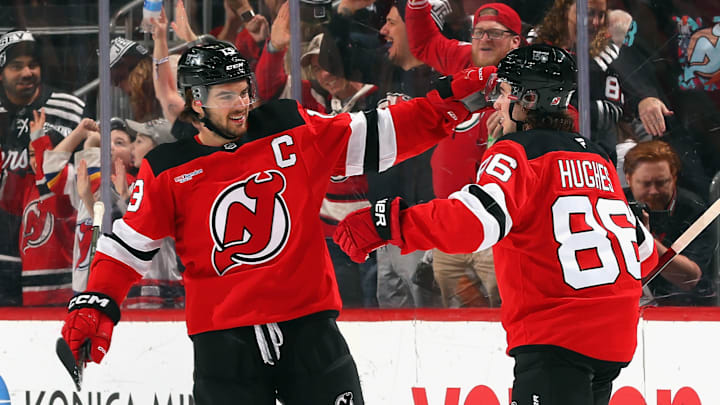The New Jersey Devils enter a pivotal 2025-26 campaign defined by strategic planning, roster depth, and a commitment to long-term competitiveness. Building on a playoff appearance last season, the organization is positioned to elevate its performance with a more balanced approach across both defense and offense, while maintaining flexibility to respond to evolving challenges over the course of the season.
Central to the Devils’ outlook is their exceptional defensive depth. Luke Hughes remains the cornerstone on the left side (despite being unsigned), complemented by Simon Nemec on the right. Both players are young, highly skilled, and already critical to the team’s defensive structure. Hughes combines elite skating and offensive vision with the ability to drive play from the back end, while Nemec offers strong positional awareness and a reliable presence in high-pressure situations.
Behind them, the organization boasts a strong pipeline of prospects—including Anton Silayev, Seamus Casey, Ethan Edwards, Daniil Orlov, and Daniil Karpovich—who provide both immediate developmental flexibility and long-term potential. While some remain in the early stages of NHL development, the abundance of high-caliber defensive talent ensures that the Devils can effectively navigate both short-term objectives and long-term planning.
From a strategic perspective, this depth is a significant advantage. With multiple assets at key positions, the franchise can manage the upcoming salary cap pressures, including Hughes’ anticipated contract, while maintaining flexibility for future roster enhancements. Such depth allows for prudent decision-making: management can prioritize sustainable growth over reactive or short-sighted transactions, a principle that underpins long-term success in today’s salary-cap environment.
Offensively, New Jersey has opportunities to improve its scoring depth and versatility. While acquiring elite-level stars like Kirill Kaprizov remains unlikely, the Devils possess promising internal contributors, such as Arseniy Gritsyuk, whose speed, tenacity, and finishing ability can inject energy into the lineup.
Additionally, targeted acquisitions via trade could further strengthen the forward lines. Potential targets—Kirill Marchenko, Drake Batherson, Ivan Barbashev, and Mason McTavish—represent attainable options that align with both team style and financial parameters. By adding complementary pieces in these areas, the Devils could create a more dynamic attack capable of competing against the league’s top teams.
Equally important is the team’s approach to cap and asset management. By avoiding overextension and focusing on sustainable roster construction, the Devils can maximize both immediate performance and long-term flexibility. Investments in goaltending, defensive pairing stability, and forward depth are complemented by an emphasis on physical discipline—a trait modeled by successful franchises such as the Florida Panthers. By combining skill, speed, and strategic physicality, New Jersey can compete in high-pressure situations and maintain resilience over the course of a demanding season.
The 2025-26 campaign also represents an opportunity to showcase the organization’s developmental pipeline. Fans and analysts alike can expect to see key contributions from emerging talents as they integrate into the team’s systems, demonstrating the value of the franchise’s investment in player development. The careful combination of youth and experience positions the Devils to maintain competitive balance, manage cap considerations effectively, and execute strategic roster adjustments throughout the season.
Challenges remain, of course. Maintaining consistent performance from young defensemen under the weight of expectations, integrating midseason acquisitions, and navigating the grind of an 82-game schedule will test the team’s resilience. However, the Devils’ leadership, both on and off the ice, is well-equipped to address these challenges. Coaching adjustments under Sheldon Keefe, combined with the maturity of the core roster, provide the framework for sustained success.
In summary, the New Jersey Devils enter the 2025-26 season with a compelling combination of depth, talent, and organizational discipline. Their defensive core, bolstered by a pipeline of highly skilled prospects, provides stability and flexibility. Offensive opportunities, both internal and via trade, can enhance scoring balance and depth. Through careful asset management, disciplined play, and strategic roster construction, the Devils are well-positioned to compete at the highest level.
For fans, stakeholders, and the broader hockey community, the message is clear: New Jersey is not only prepared to contend this season but is laying the foundation for sustained success. The team’s blend of youth, experience, and forward-thinking management positions it to pursue its fourth Stanley Cup with both confidence and strategic precision. As the puck drops at the Prudential Center, the Devils exemplify a franchise that balances immediate competitiveness with long-term vision—an organization primed for success in 2025-26 and beyond.
